
A FRAMEWORK FOR

UNDERSTANDING
POVERTY

FOURTH REVISED EDITION

A FRAMEWORK FOR

UNDERSTANDING
POVERTY

FOURTH REVISED EDITION

Ruby K. Payne, Ph.D.




Contents
................................................................... i
........................... 27
............................... 37
............... 47
................ 63
................................................... 69
............................................................... 77
............. 87
.................................................................. 113
.................................................................... 163
............................................................... 187
........................................................................... 195
OTHER SELECTED TITLES BY RUBY K. PAYNE, PH.D.
Un Marco Para Entender La Pobreza (Spanish translation of Framework)
Understanding Learning
Learning Structures
Preventing School Violence by Creating Emotional Safety. Video Series & Manual
Meeting Standards & Raising Test ScoresWhen You Don't Have Much Time or Money: Video Series & Manual (Payne & Magee)
Removing the Mask: Giftedness in Poverty (Slocumb & Payne)
Bridges Out of Poverty. Strategies for Professionals and Communities
(Payne, DeVol, & Dreussi Smith)
Think Rather of Zebra (Stailey & Payne)
What Every Church Member Should Know About Poverty (Payne & Ehlig)
Living on a Tightrope-A Survival Handbook for Principals
(Sommers & Payne)
Hidden Rules of Class at Work (Payne & Krabill)

Acknowledgments
A very special thanks to...
Judy Duncan, the assistant principal at Bowie Elementary School, who first approached me with the idea of writing a book about poverty.
The teachers at Bowie Elementary, who were so gracious and receptive to the ideas presented to them.
Sara Hector, field service agent for the Texas Education Agency, whose continuing encouragement and support led to the development of this book.
Jay Stailey, principal at Carver Elementary School and president of the National Storytelling Association, whose conversations about poverty and stories stimulated my thinking.
Karen Coffey, colleague and Project Read consultant, who provided suggestions.
Carol Ellis, my secretary, who knew the hours I was putting in at home on the book and was supportive.
Sue Franta, for all her assistance and support.
Cheryl Evans, for her illustrations, editing, and layout design.
Jim Grant and Dan Shenk, for their editing assistance.
Donna Magee, for her assistance with the Research Notes.
Anna Elmore, for her countless revisions and endless patience.
The TEAM project members at the University of Houston-Clear Lake for their interest and encouragement.
Frank Payne, my former husband, and Tom Payne, our son, whose patience, support, encouragement, and love have allowed this book to happen.
aha! Process, Inc. exists to improve the education and lives of individuals in poverty around the world. It provides an additive model that recognizes that people in poverty, middle class, and wealth are all problem solvers. The focus is on solutions, shared responsibilities, new insights, and interdependence. This work is about the resulting connectedness and about relationships; it is about "us."

Additive Model: aha! Process's Approach to Building High-Achieving Schools
SUMMARY
An additive model, implicit throughout this book and analyzed more directly in the Appendix on page 163, is a vital tool for better understanding and addressing poverty, as well as the underlying factors that perpetuate it.
Dr. Ruby K. Payne's additive model:
Honors internal assets of people from all economic classes.Names problems accurately.Identifies the mindsets and patterns that individuals use to survive different economic environments-and provides a vocabulary to talk about it.Identifies strengths and resources already found in the individual, family, school, and community-and adds new information and a new perspective for creating and growing resources.Offers economic diversity as a prism through which individuals and schools can analyze and respond to their issues.Identifies skills, theories of change, program designs, partnerships, and ways of building schools where students achieve.Encourages the development of strategies to respond to all causes of poverty.

Introduction
 his book came to be because so many people were asking questions that, finally, I promised to put things in writing. My name is Ruby Payne, and I never realized that the information I had gathered over the years about poverty, middle class, and wealth would be of interest to other people.
his book came to be because so many people were asking questions that, finally, I promised to put things in writing. My name is Ruby Payne, and I never realized that the information I had gathered over the years about poverty, middle class, and wealth would be of interest to other people.
It wasn't until an assistant principal, Judy Duncan, came to me and asked about a staff-development program for her faculty on discipline-and referenced the number of student referrals they were having-that I even began talking about the differences. She noted how the population in the school had changed over the past three years from 24% low income (as measured by the number of students on free and reduced-price lunch) to 6o% low income. As she described the kinds of discipline situations they were experiencing, I would explain why those behaviors were happening. Finally, she stopped me and asked where I was getting my information. It was at that point that I realized that I had been gathering data for 24 years.
Where had I gotten the data? First of all, I was married more than 30 years to Frank, who grew up in poverty because his father died when he was 6. Though it was situational poverty, he lived for several years with those who were in generational poverty. Over the years, as I met his family and the many other players in the "neighborhood," I came to realize there were major differences between generational poverty and middle class-and that the biggest differences were not about money. But what put the whole picture into bas-relief were the six years we spent in Illinois among the wealthy. It was the addition of the third dimension, wealth, that clarified the differences between and among poverty, middle class, and wealth.
Next page
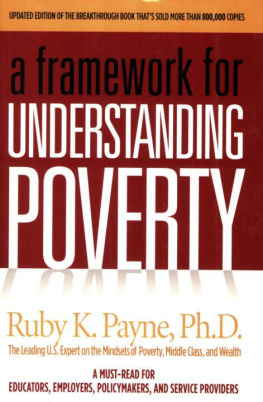
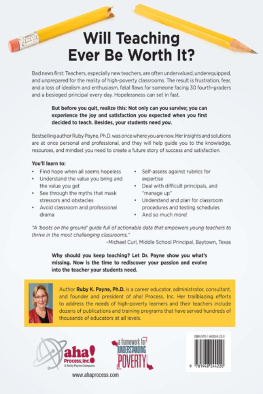

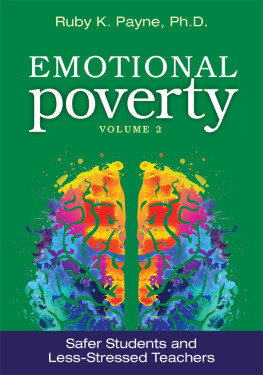

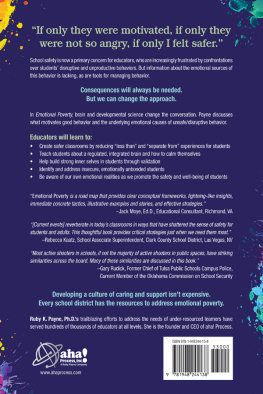


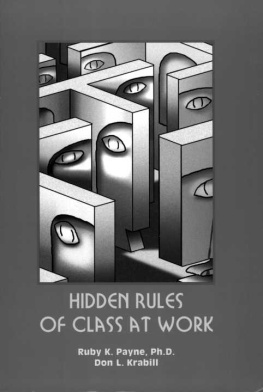
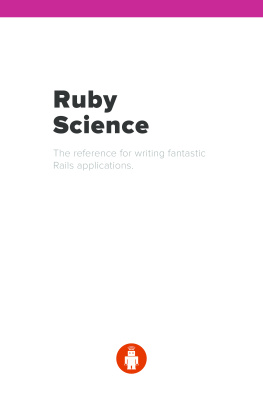

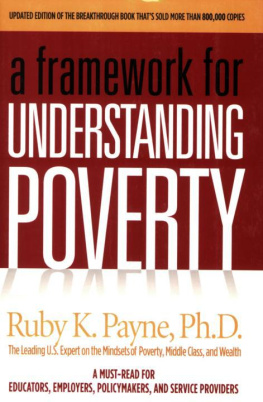














 his book came to be because so many people were asking questions that, finally, I promised to put things in writing. My name is Ruby Payne, and I never realized that the information I had gathered over the years about poverty, middle class, and wealth would be of interest to other people.
his book came to be because so many people were asking questions that, finally, I promised to put things in writing. My name is Ruby Payne, and I never realized that the information I had gathered over the years about poverty, middle class, and wealth would be of interest to other people.